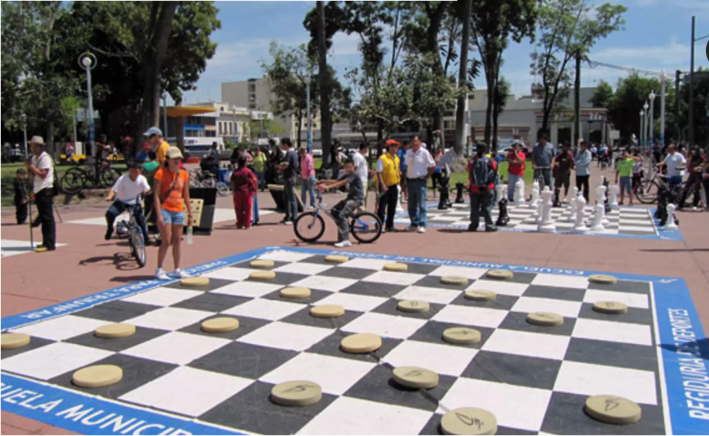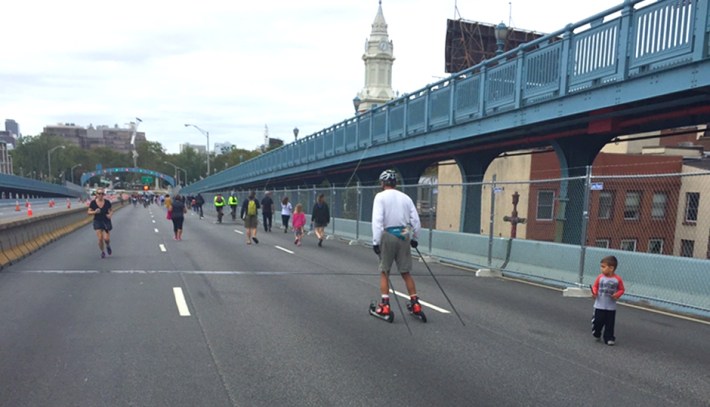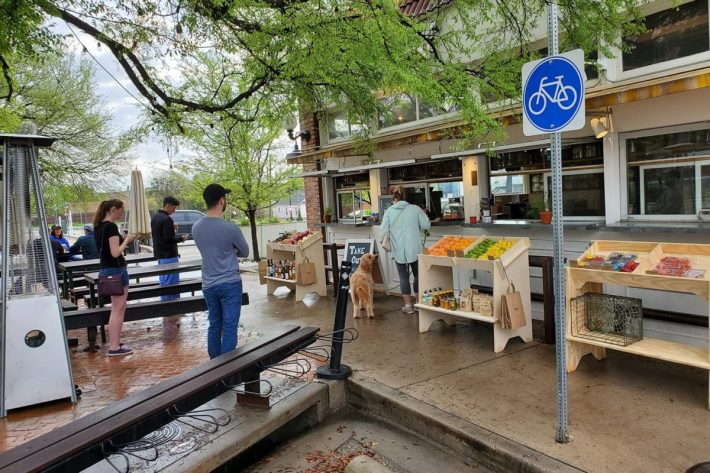How to Open Streets Right During Social Distancing
3:43 PM EDT on April 8, 2020

Source: Philadelphia Magazine.
Editor’s note: This is the third article in a series on how cities and residents can coordinate an efficient and effective emergency response to the unprecedented impact the novel coronavirus crisis is having on our nation’s roads and streets. Read the first installment on slowing down cars here and the second installment on how to safely keep parks open here. And be sure to follow the hashtag #COVIDSafeStreets to read along as the series continues.
Safe streets advocates are finding they need a new blueprint for how to close off streets to cars during the COVID-19 outbreak — because the hyper-social Open Streets model isn't going to cut it in the era of social distancing.
In the U.S., the Open Streets approach has typically looked like a slightly-bigger-than-usual block party: temporary events spanning anywhere from a few blocks to a few miles, with extensive programming, a full-scale staff of volunteers and traffic cops manning every intersection, and a goal of bringing neighbors out to congregate and play on streets that are normally reserved for car travel. That's a beautiful idea in the best of times, but nothing about that approach is suitable for a pandemic — as evidenced by New York's attempt at making the Open Streets model work, which resulted in a few paltry, over-policed programs that only lasted a few blocks and stayed up for a few days.
Here's how leading tactical urbanism experts are thinking through how we can adapt the Open Streets model to these challenging times — by re-thinking them from the ground up.
1. Think less 'Block Party' and more 'Streets-to-Trails'
Open Streets don't need to turn into a big, joyous, socially undistant block party like this:

Instead, cities can choose a "streets to trails" program, where the emphasis is less on socializing with neighbors and more on keeping bodies safely in motion for transportation and exercise. As cars on our swiftly-emptying roads speed up, creating a little more car-free space for people to walk and bike besides on the sidewalk is crucial right now — and as a happy side effect, it creates a little more space for socializing at a safe distance, too.
"What we're seeing nationwide is that our trail system is being overwhelmed," said Jason Roberts of the Better Block Foundation, which is in talks to help develop a streets-to-trails program for the city of Dallas. "To keep social distance, we need to make sure people have a safe way to get out and get some exercise."
This is what an Open Streets event can look like. And remember: roadways like this could be even less crowded if the city creates many car-free streets.

2. Rethink the 'where,' not the 'why'
In a normal, non-virus age, Open Streets events are often most impactful when they occur in big, visible areas where a maximum number of people can witness just how many amazing things their streets can be used for when we subtract cars from the equation.
But in the age of COVID-19, we need to be a little more utilitarian when we pick which streets to close — and focus on places where people need to get around, whether or not they'll be seen doing it.
The first place we should start, the advocates we spoke to argued, is with closing off as many streets as possible that run through our parks to motor vehicles — not just a handful of them, as may cities are doing now. And it'd be even better to close off roads adjacent to parks, too: Mike Lydon and Tony Garcia, tactical urbanism superstars and co-principals of Street Plans, offered particular applause to Minneapolis' decision to allow limited road closures near its river front.
Next stop: the cul-de-sacs. Streets that are already pretty quiet have absolutely no reason to allow non-resident traffic right now, when the risk of killing new crowds of of walker vastly outweighs the risk of holding up a traffic pattern that has largely come to a standstill. And that goes for through-streets that don't connect major essential services, too.
Third stop: those small, walkable shopping districts where all the businesses are closed anyway. Jason Roberts of Better Block thinks it's particularly important to give residents safe, contactless access to window shopping, street vendors, and even shuttered restaurants, which can be converted into open-air markets through Better Block's free downloadable shelf plans:

After that, experts argue, street closures can grow from there as traffic patterns adjust — but it's best to start with the low-hanging fruit. If we're in for a long haul with this virus — which it's increasingly looking like we are — we'll get to some of those bigger thoroughfares in time if we're strategic.
3. Cut the red tape
Perhaps the most challenging part of repurposing the Open Streets model as an coronavirus emergency response strategy is simple bureaucracy. But there's a lot cities can do to cut through the red tape.
Drastically simplifying the process for any neighborhood association or resident to request a street closure permit is a must-do. And in many cases — think that quiet, quarter-mile cul-de-sac — it might even be wise to make permitting optional, and waive requirements for traffic cops to monitor intersections while you're at it.
"It's a big ask for cities to let go a little and not exert their normal level of control over public space," said Mike Lydon. "But where I live in New York City, there are hundreds of block parties every year, and police aren't sweeping through and knocking them down for blocking traffic. It can be done another way."
And once they have their permits in hand, Open Streets organizers would be wise to keep things simple, too. Experts say it's time to ditch your dreams of extensively programmed outdoor parties and focus on the simple stuff: highly visible barricades, clear signage, and good online communication to let residents know when and where it's safe to walk in the street.
"People really do find ways of doing street closures safely and with very limited resources." said Tony Garcia. "In a lot of cases, I think cities just need to empower residents to do this, and then get out of the way."
4. Don't forget about joy
No, an Open Streets event during the age of the novel coronavirus pandemic should probably not involve giant games of Connect Four, close-quarters community dance parties, and hugging every neighbor on your block. But that doesn't mean they have to be joyless — or even simply utilitarian.
Remember: something as simple as sidewalk chalk is a form of tactical urbanism, because it slows down traffic and encourages people to pay attention to their surroundings. It can also be done perfectly safely while social distancing. (Just remember to set it with hairspray for best results.
No, we won't have a whole lot of Easter egg hunts in public parks right now, but we can still do a socially distanced form of the scavenger hunt to keep kids engaged.
At the end of the day, nothing is normal right now — and our Open Streets events can't be, either. But socially distanced experience of public space is one of the few things we have left to bring us real joy in this trying global moment, and we need at least some measure of joy to get us through this crisis. That means we owe it to ourselves, and to our neighbors, to expand make public space as safe and expansive much as we feasibly can.
"If joy were a human right, just like housing and human right, you’d see Open Streets as being the biggest demonstration of that human right," said Ramel Pascual, CEO of the Open Streets nonprofit CicLAvia. "When all this is over, I think we're going to get together and have a really big party in the streets."
Kea Wilson has more than a dozen years experience as a writer telling emotional, urgent and actionable stories that motivate average Americans to get involved in making their cities better places. She is also a novelist, cyclist, and affordable housing advocate. She previously worked at Strong Towns, and currently lives in St. Louis, MO. Kea can be reached at kea@streetsblog.org or on Twitter @streetsblogkea. Please reach out to her with tips and submissions.
Read More:
Stay in touch
Sign up for our free newsletter
More from Streetsblog USA
How Car-Centric Cities Make Caring For Families Stressful — Particularly For Women
Women do a disproportionate share of the care-related travel their households rely on — and car-focused planning isn't making matters easier.
Wednesday’s Headlines Build Green
A new bill dubbed "Build Green" would replace many of the climate-friendly elements Sen. Joe Manchin insisted on stripping from the Inflation Reduction Act.
E-Bikes and Creating Financially Sustainable Bike Share Programs
The number of customers using bike share in the U.S. and Canada is now at an all-time high thanks to e-bikes.
Tuesday’s Headlines Pick the Low-Hanging Fruit
Greg Shill argues that if a transformative road redesign isn't possible, it's time to talk about second-best strategies.
How to Fight a Texas-Sized Freeway Battle
A new book explores how Texas advocates are fighting back against destructive highway expansions. But what happened to those projects since it was sent to the printer?




